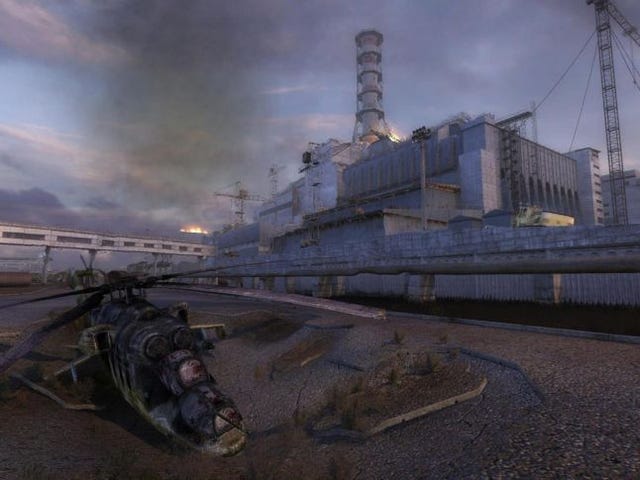Trending
Opinion: How will Project 2025 impact game developers?
The Heritage Foundation's manifesto for the possible next administration could do great harm to many, including large portions of the game development community.

Featured Blog | This community-written post highlights the best of what the game industry has to offer. Read more like it on the Game Developer Blogs or learn how to Submit Your Own Blog Post
Every aspect of S.T.A.L.K.E.R. is deeply imbued with narrative meaning - including the mechanics. This game design deep dive looks into how its mechanics were used for worldbuilding.

Certain mechanics divide opinions. While designers want their games to have as much depth and complexity as possible, some argue that survival systems like radiation, hunger, and bleeding actually detract from the quality of gameplay in most genres by stepping too heavily on player agency. This line of reasoning implies that first-person shooters like S.T.A.L.K.E.R. should be met with boiling frustration. But they’re not.
Radiation, hunger, and bleeding are some of S.T.A.L.K.E.R.’s core gameplay mechanics. Ignoring them isn’t really an option. You’ll probably never even make it past the tutorial area without popping some radiation pills, chomping down a few loaves of bread, or applying at least one bandage. Shouldn’t this foil the fun? Survival systems like radiation, hunger, and bleeding don’t ruin S.T.A.L.K.E.R. for a simple reason: they’re completely consistent with its world. In fact, they even help to build it.

The game is a master class in worldbuilding
Walk around Chernobyl for even a few minutes and you’ll pick up on something strange: it’s full of rather ominous green clouds. These atmospheric anomalies aren’t just alluring, though — they’re deadly. Don’t get too close or you’ll end up with a bad case of radiation poisoning. This can only get worse over time, so you’ll eventually have to seek out some form of treatment. You can pick up a cure pretty much anywhere, but you’ll nonetheless find yourself stockpiling drugs and other quick fixes. Radiation sickness becomes increasingly hard to fend off as you venture deeper into the Zone.
The game’s radiation system helps to strengthen S.T.A.L.K.E.R.’s narrative through active worldbuilding. Chernobyl’s fallout-laden landscape is apparently inhospitable, so it makes perfect sense for the player to suffer during its traversal. The contrary would actually seem strange. Communicating the same sense of desperation as the game’s aesthetic and story, the radiation system is also consistent with S.T.A.L.K.E.R.’s overall theme. Radiation though isn’t the only mechanic which accomplishes this. Hunger has a hand in things, too.

Chernobyl is almost completely inhospitable
Comb through just about any container in the game and you’ll come away with some ropes of sausage and a few loaves of bread. Sausage in particular can be sold for a fair price almost anywhere, but odds are that you’ll end up hoarding the majority of your spoils. You get increasingly hungry in S.T.A.L.K.E.R. over time, so you’ll have to keep sucking down sausages or face the resulting consequences. The game pulls no punches when it comes to consumption. You’ll eventually die.
Similar to the game’s radiation system, hunger serves to expand S.T.A.L.K.E.R.’s narrative by helping to build its world. Food rations are supposed to be scarce in Chernobyl, so why shouldn’t the player have to feel a few hunger pangs? (In video game terms, this naturally means a hunger bar). Since the hunger system is completely consistent with S.T.A.L.K.E.R.’s world, players are quite a bit less likely to question this otherwise divisive mechanic — or become frustrated by it.

Chernobyl's inhabitants have to compete for resources
Since you mostly just run around shooting things, the combat in S.T.A.L.K.E.R. should be familiar to any fan of the first-person shooter genre. The game diverges from the majority of other shooters in so far as enemy bullets make you bleed, though. Step out from behind cover and there’s a high likelihood that you’ll bite one of these. You begin hemorrhaging with every hit, so you’ll eventually have to put something on your wounds. Bandages are thankfully a common commodity in Chernobyl.
Pretty much everything in S.T.A.L.K.E.R. seems like it wants to kill you. This definitely comes through in the game’s aesthetic and story, but it finds an expression in mechanical terms, too. Similar to its hunger and radiation systems, bleeding helps to reinforce the game’s overall theme of desperation. Layering on the pressure, this mechanic helps to create immersion by evoking the same sense of danger which seems to radiate outward from the Zone.

Combat is particularly intense because of the game's bleeding mechanic
Games are made up of three components: mechanic, aesthetic, and story. Converging in the form of a game world, each one communicates to the player in a slightly different way. The most immersive worlds are born when designers ensure that every component sings the same song. This mostly takes place through narrative control. The best experiences in other words are created when mechanics and aesthetics are imbued with narrative meaning.
The aesthetics in S.T.A.L.K.E.R. definitely match its narrative, but what about the game’s mechanics? Some argue that survival systems like radiation, hunger, and bleeding actually detract from the quality of gameplay in genres like the first-person shooter by restricting player agency. This means that S.T.A.L.K.E.R. should produce only frustration. Somehow it doesn’t. The game will never meet with rage because it creates a world where mechanic, aesthetic, and story are mutually reinforcing. This was accomplished by allowing its narrative to permeate every aspect of the gameplay experience.
This article was reproduced from "Building Worlds," posted to SlowRun on July 22, 2018.
Read more about:
Featured BlogsYou May Also Like